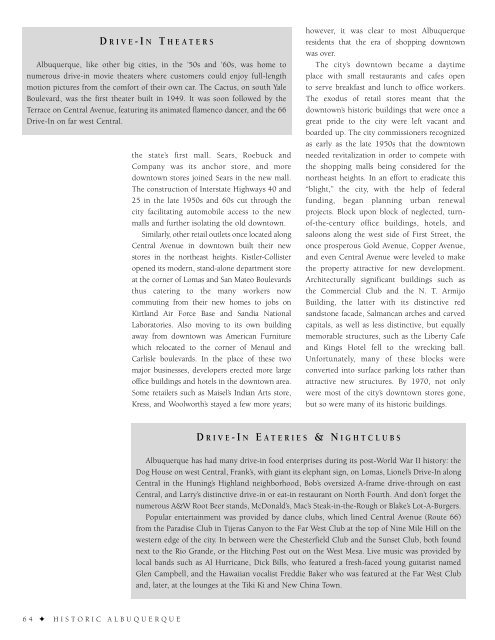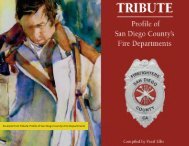Historic Albuquerque
An illustrated history of the City of Albuquerque, New Mexico and the surrounding area, paired with the histories of companies, families and organizations that make the region great.
An illustrated history of the City of Albuquerque, New Mexico and the surrounding area, paired with the histories of companies, families and organizations that make the region great.
You also want an ePaper? Increase the reach of your titles
YUMPU automatically turns print PDFs into web optimized ePapers that Google loves.
D RIVE-IN<br />
T HEATERS<br />
<strong>Albuquerque</strong>, like other big cities, in the ’50s and ’60s, was home to<br />
numerous drive-in movie theaters where customers could enjoy full-length<br />
motion pictures from the comfort of their own car. The Cactus, on south Yale<br />
Boulevard, was the first theater built in 1949. It was soon followed by the<br />
Terrace on Central Avenue, featuring its animated flamenco dancer, and the 66<br />
Drive-In on far west Central.<br />
the state’s first mall. Sears, Roebuck and<br />
Company was its anchor store, and more<br />
downtown stores joined Sears in the new mall.<br />
The construction of Interstate Highways 40 and<br />
25 in the late 1950s and 60s cut through the<br />
city facilitating automobile access to the new<br />
malls and further isolating the old downtown.<br />
Similarly, other retail outlets once located along<br />
Central Avenue in downtown built their new<br />
stores in the northeast heights. Kistler-Collister<br />
opened its modern, stand-alone department store<br />
at the corner of Lomas and San Mateo Boulevards<br />
thus catering to the many workers now<br />
commuting from their new homes to jobs on<br />
Kirtland Air Force Base and Sandia National<br />
Laboratories. Also moving to its own building<br />
away from downtown was American Furniture<br />
which relocated to the corner of Menaul and<br />
Carlisle boulevards. In the place of these two<br />
major businesses, developers erected more large<br />
office buildings and hotels in the downtown area.<br />
Some retailers such as Maisel’s Indian Arts store,<br />
Kress, and Woolworth’s stayed a few more years;<br />
however, it was clear to most <strong>Albuquerque</strong><br />
residents that the era of shopping downtown<br />
was over.<br />
The city’s downtown became a daytime<br />
place with small restaurants and cafes open<br />
to serve breakfast and lunch to office workers.<br />
The exodus of retail stores meant that the<br />
downtown’s historic buildings that were once a<br />
great pride to the city were left vacant and<br />
boarded up. The city commissioners recognized<br />
as early as the late 1950s that the downtown<br />
needed revitalization in order to compete with<br />
the shopping malls being considered for the<br />
northeast heights. In an effort to eradicate this<br />
“blight,” the city, with the help of federal<br />
funding, began planning urban renewal<br />
projects. Block upon block of neglected, turnof-the-century<br />
office buildings, hotels, and<br />
saloons along the west side of First Street, the<br />
once prosperous Gold Avenue, Copper Avenue,<br />
and even Central Avenue were leveled to make<br />
the property attractive for new development.<br />
Architecturally significant buildings such as<br />
the Commercial Club and the N. T. Armijo<br />
Building, the latter with its distinctive red<br />
sandstone facade, Salmancan arches and carved<br />
capitals, as well as less distinctive, but equally<br />
memorable structures, such as the Liberty Cafe<br />
and Kings Hotel fell to the wrecking ball.<br />
Unfortunately, many of these blocks were<br />
converted into surface parking lots rather than<br />
attractive new structures. By 1970, not only<br />
were most of the city’s downtown stores gone,<br />
but so were many of its historic buildings.<br />
D RIVE-IN E ATERIES & N IGHTCLUBS<br />
<strong>Albuquerque</strong> has had many drive-in food enterprises during its post-World War II history: the<br />
Dog House on west Central, Frank’s, with giant its elephant sign, on Lomas, Lionel’s Drive-In along<br />
Central in the Huning’s Highland neighborhood, Bob’s oversized A-frame drive-through on east<br />
Central, and Larry’s distinctive drive-in or eat-in restaurant on North Fourth. And don’t forget the<br />
numerous A&W Root Beer stands, McDonald’s, Mac’s Steak-in-the-Rough or Blake’s Lot-A-Burgers.<br />
Popular entertainment was provided by dance clubs, which lined Central Avenue (Route 66)<br />
from the Paradise Club in Tijeras Canyon to the Far West Club at the top of Nine Mile Hill on the<br />
western edge of the city. In between were the Chesterfield Club and the Sunset Club, both found<br />
next to the Rio Grande, or the Hitching Post out on the West Mesa. Live music was provided by<br />
local bands such as Al Hurricane, Dick Bills, who featured a fresh-faced young guitarist named<br />
Glen Campbell, and the Hawaiian vocalist Freddie Baker who was featured at the Far West Club<br />
and, later, at the lounges at the Tiki Ki and New China Town.<br />
64 ✦ HISTORIC ALBUQUERQUE
















